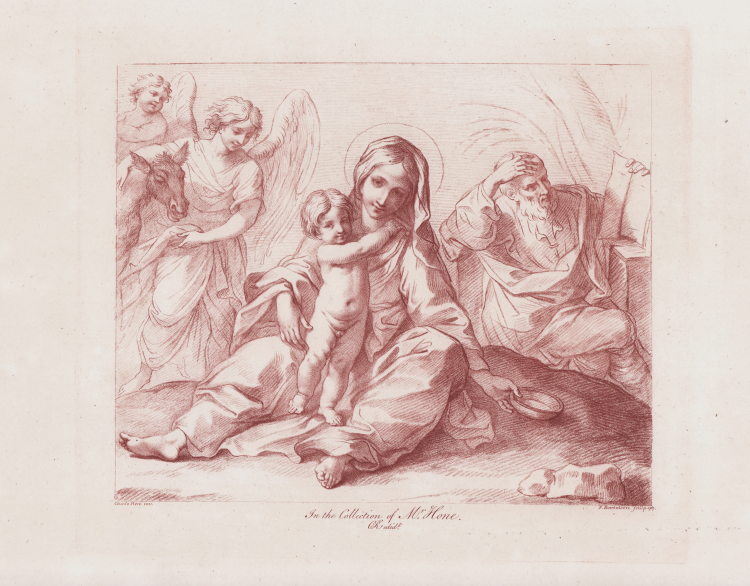



| Reference: | S49852 |
| Author | Francesco BARTOLOZZI |
| Year: | 1767 |
| Measures: | 300 x 255 mm |


| Reference: | S49852 |
| Author | Francesco BARTOLOZZI |
| Year: | 1767 |
| Measures: | 300 x 255 mm |
The Holy Family resting, with Mary and the Child at the centre, looking towards the viewer, Joseph on the right reading a book, and an angel with a donkey on the left; after Guido Reni; in rectangular frame in imitation of a wash mount.
Maniere de crayon, 1767, lettered below the image with production details.
From Tome I of Charles Rogers “A Collection of Prints in Imitation of Drawings to which are annexed lives with explanatory and critical notes by Charles Rogers Esq. F.R.S. S.A.L. / Quantanus nobis denegatur diu viver relinquamus aliquid quo nos vixisse testemur. Plin. Lib. III. Epist. 7 / Stampato da J. Nicholls, successore di Mr Bowyer e venduto da John Boydell, incisore, n. 93, Cheapside. Benjamin White, presso Horace's Head, Fleet-Street. Peter Molini, in Oxendon-Street, Hay-Market M.DCC.LXXVIII”.
The plates were engraved after drawings in major British collections, including Charles Rogers' own, and published in two volumes in London.
Francesco Bartolozzi, the son of a Florentine goldsmith, met German engraver Joseph Wagner at whose workshop, the most important in Venice, where he moved in August 1748. In the lagoon city Bartolozzi remained for sixteen years, participating in artistic life and coming into contact with major publishers and printers, as well as men of culture. He alternated between his own works and translations by other artists in collaboration with Wagner, such as the series devoted to Guercino to which he devoted himself almost exclusively between 1761 and 1765. These are the years when Bartolozzi becomes the owner of his own workshop. He then moved to England, where he stayed for about forty years, and where he devoted himself mainly to the activity of translation, alternating with equal success between interpreting the works of famous painters of the past and those of his contemporaries. In addition to drawings by Guercino in the royal collection, the artist reproduced drawings by the Carracci, Pietro da Cortona, Guido Reni, Carlo Maratta, and his friend Giovan Battista Cipriani.
A very good impression on contemporary laid paper, with margins, a light foxing, otherwise in good condition.
Francesco BARTOLOZZI (Firenze, 1727; Lisbona, 7 Marzo 1815)
|
Printmaker, draughtsman and painter, active also in England. He was the son of Gaetano Bartolozzi, a goldsmith, with whom he trained before entering the Accademia di Belle Arti in Florence. There he studied under Giovanni Domenico Ferretti and Ignazio Hugford. He also extended his knowledge of the Antique with a short trip to Rome. He is said to have become an adept painter of miniatures, watercolours and pastels, and an accomplished draughtsman; but he soon concentrated on engraving. Works identified as from his Florentine period include the series of plates after Domenichino’s frescoes in the abbey of Grottaferrata and those of religious paintings by Anton Domenico Gabbiani.
|
Francesco BARTOLOZZI (Firenze, 1727; Lisbona, 7 Marzo 1815)
|
Printmaker, draughtsman and painter, active also in England. He was the son of Gaetano Bartolozzi, a goldsmith, with whom he trained before entering the Accademia di Belle Arti in Florence. There he studied under Giovanni Domenico Ferretti and Ignazio Hugford. He also extended his knowledge of the Antique with a short trip to Rome. He is said to have become an adept painter of miniatures, watercolours and pastels, and an accomplished draughtsman; but he soon concentrated on engraving. Works identified as from his Florentine period include the series of plates after Domenichino’s frescoes in the abbey of Grottaferrata and those of religious paintings by Anton Domenico Gabbiani.
|